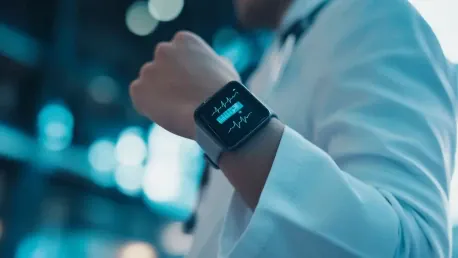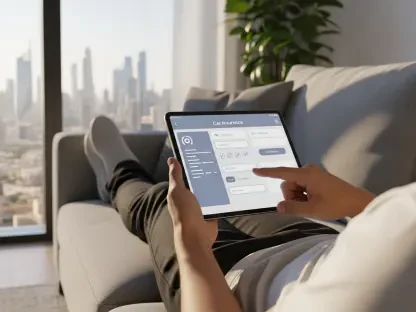Over the past decade, patient care has undergone a significant transformation, largely driven by advances in medical wearable technology. These devices have become indispensable tools, particularly in managing chronic illnesses such as diabetes, hypertension, and cardiovascular diseases. Healthcare professionals report that wearables have facilitated a shift from reactive to proactive healthcare, empowering individuals to monitor their health in real time and take control of their well-being. This shift is revolutionizing the way healthcare is approached, leading to better outcomes and enhanced patient engagement.
The Rise of Medical Wearables
Surge in Adoption
The adoption of medical wearables such as smartwatches, fitness trackers, and biosensors has surged, especially in the wake of the COVID-19 pandemic. These devices, designed to be worn on the body, can monitor various health parameters including blood sugar levels, heart rate, physical activity, sleep patterns, and blood oxygen levels. The pandemic underscored the importance of monitoring vital signs, making devices like pulse oximeters household essentials, a trend that has only grown since. The ubiquity of these devices in daily life illustrates their rising importance in modern healthcare.
Medical wearables offer convenience and immediacy in health monitoring, enabling users to track health metrics continuously. This functionality has proven invaluable for individuals with chronic conditions who require constant oversight. The data gathered from these devices can be easily shared with healthcare providers, facilitating timely and informed medical decisions. Furthermore, the increasing accuracy and sophistication of wearables make them reliable tools for detecting early signs of health issues, prompting preventive measures before conditions worsen. This aspect positions wearables as crucial elements in a proactive healthcare model.
Case Studies and Real-World Impact
One notable case illustrating the impact of wearables involves a 40-year-old patient who used an Apple Watch to detect an unusual heart rate. Though asymptomatic, the patient was found to be pre-diabetic with high lipid levels, which was detected through blood tests following the irregular readings from the wearable. By making lifestyle changes such as improving diet and increasing exercise, the patient restored normal health parameters, exemplifying how wearables can prevent diseases before they fully manifest. This case highlights the profound impact wearable technology can have on day-to-day health management.
Real-world testimonies like this underscore the potential of wearables to serve as early warning systems. Wearables can detect subtle changes in physiological data that might go unnoticed without continuous monitoring. This capability is particularly beneficial for detecting asymptomatic conditions, leading to early interventions that can prevent severe health issues. As healthcare continues to evolve, the role of wearables in empowering individuals to take charge of their health and make informed decisions is becoming increasingly evident. Their potential in transforming healthcare is monumental, marked by numerous success stories and ongoing innovations.
Beyond Diabetes Management
Cardiac and Respiratory Monitoring
Medical wearables have applications beyond diabetes management. For instance, the FDA approved the Apple Watch to detect atrial fibrillation, a serious cardiac condition. Instances where Apple Watches have alerted individuals to irregular heart rates abound, enabling early interventions and preventing potentially life-threatening complications. Wearables have also been vital in monitoring respiratory health, crucial during the pandemic, by tracking respiratory rates, oxygen saturation, and pulse rates, especially in patients with conditions like asthma or chronic obstructive pulmonary disease (COPD).
Wearables designed for cardiac monitoring can continuously track heart rhythms, providing valuable data that can help diagnose and manage conditions like arrhythmias. This proactive approach to heart health can lead to early treatment and better long-term outcomes. In respiratory health, wearables can detect exacerbations in conditions like COPD, prompting timely medical attention and reducing hospital visits. The continuous feedback provided by these devices is transforming the management of chronic respiratory illnesses, offering patients a better quality of life and reducing healthcare costs.
Real-Time Data for Informed Decisions
Importantly, wearables provide real-time data that offers valuable insights, aiding in both patient and healthcare provider decision-making. Continuous Glucose Monitors (CGM), for example, help diabetic patients track blood glucose levels, motivating changes based on immediate feedback. For patients managing cardiovascular conditions, wearables deliver alerts for irregular heart rhythms, prompting timely medical interventions. The real-time data collection and transmission capabilities of wearables are enhancing patient care by promoting more informed and timely decisions.
This timely data allows healthcare providers to monitor the effectiveness of treatment plans and make adjustments as needed. For example, CGMs provide diabetics with real-time glucose readings, allowing them to adjust their diet or medication promptly. Similarly, wearables that monitor cardiac health can alert users and doctors to anomalies, enabling quick responses that can prevent serious complications. This continuous loop of feedback and adjustment is paving the way for tailored treatments and improved patient outcomes, making healthcare more adaptive and responsive.
Enhancing Patient-Doctor Interactions
Telehealth Integration
These devices enhance patient-doctor interactions, particularly through telehealth platforms. By integrating data from wearables, healthcare providers can remotely monitor patient health, leading to more accurate diagnoses and personalized treatment plans. CGMs, for example, allow providers to monitor blood sugar levels in real-time and adjust insulin dosages remotely, improving the accessibility and convenience of healthcare while ensuring treatment adherence. The convergence of telehealth and wearable technology is redefining patient care, making it possible to offer high-quality medical support from a distance.
Telehealth, bolstered by data from wearables, allows for continuous patient monitoring without the need for frequent in-person visits. This approach is particularly beneficial for patients with mobility issues or those living in remote areas. Wearables enable doctors to keep track of a patient’s health metrics in real-time, facilitating timely interventions and reducing the need for hospital admissions. This integration is making healthcare more accessible and efficient, significantly improving the management of chronic conditions and routine check-ups. The future of telehealth looks promising with wearables at its core.
Overcoming Challenges
However, despite their advantages, high costs associated with medical wearables pose a significant barrier, especially in countries like India. The recurring expenses, such as sensors for CGMs, add up, making them unaffordable for many. While short-term use can still provide valuable health insights, continued affordability remains a concern. Efforts to make wearables more cost-effective and accessible are imperative to ensure that their benefits reach a broader population. Addressing these financial challenges is crucial for the widespread adoption of wearable technology in healthcare.
Additionally, wearables must overcome hurdles related to data security and user privacy. As these devices collect sensitive health information, ensuring that data is securely stored and transmitted is paramount. Patients need to feel confident that their personal health data is protected from unauthorized access. Manufacturers and healthcare providers must work together to establish robust security protocols and ensure adherence to privacy regulations. Balancing accessibility, cost, and security will be key to maximizing the potential of wearables in transforming patient care.
Future Innovations in Medical Wearables
Emerging Technologies
Researchers are continually innovating, with future medical wearable technology promising even greater integration into daily life. Smart textiles, for instance, are being developed with sensors embedded directly into clothing to track various health parameters non-invasively. Non-invasive glucose monitoring through biofluids like sweat, saliva, or tears is also under exploration, aiming to eliminate the need for skin-puncturing devices, which could make wearables more appealing and less intrusive. These advancements represent the next frontier in wearable technology, where devices seamlessly blend into everyday activities.
Emerging technologies in wearables are focused on making devices smaller, more user-friendly, and more accurate. For instance, smart contact lenses that monitor glucose levels in tears are real possibilities being explored, offering a less invasive alternative for diabetics. Moreover, integrating artificial intelligence with wearables could provide predictive analytics, helping to forecast potential health issues before they arise. These innovations hold great promise for further enhancing the proactive management of health, pushing the boundaries of what medical wearables can achieve.
Balancing Benefits and Limitations
Over the past ten years, patient care has seen a major transformation, largely due to the progress in medical wearable technology. These devices have become critical tools, especially in managing chronic conditions like diabetes, hypertension, and heart diseases. Healthcare experts note that wearables have enabled a significant shift from reactive to proactive healthcare. This change allows individuals to monitor their health in real time, giving them the ability to take control of their well-being. The impact of this shift is profound, revolutionizing healthcare approaches and leading to better patient outcomes and increased engagement. Wearable technology not only aids in early detection but also provides continuous monitoring, which can prevent complications before they escalate. This comprehensive health monitoring fosters a more personalized healthcare experience as patients and healthcare providers can make informed decisions quickly. As a result, the healthcare field is seeing a positive change, making treatments more efficient and paving the way for innovative methods in patient care, which collectively enhances the quality of life.









